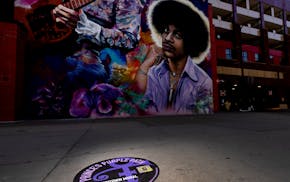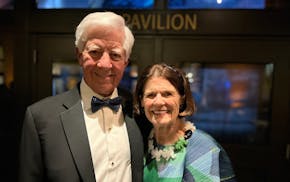A portrait of former Supreme Court Justice Thurgood Marshall includes mung beans.
A portrait of Supreme Court Justice Sonia Sotomayor features dried red peppers for her red lips.
These two "seedy" portraits of famous judges are at the U.S. Courthouse in Minneapolis, but they're nothing like the stark photographs of the president and vice president that hang near the entrance.
The eyes, noses, lips, skin tones and robes of these Supreme Court justices were painstakingly crafted using seeds, beans, grains, quinoa, sunflower seeds, flaxseed, lentils, dried peppers and more.
"The smallest seed I've ever used, which I wouldn't do again, is thyme [which she used in her Marshall portrait]," said Laura Melnick, a crop artist and civil poverty lawyer. She eyed her portrait of Thurgood Marshall, a seed masterpiece. At the top she included a quote from Marshall: "We must dissent. ... America has no choice but to do better."
"The writing always takes me a really long time," she said.
Minnesotans are used to seeing crop art at the Minnesota State Fair, but not in the lobby of a federal courthouse ― until now.
A new exhibition of 17 crop artworks, titled "Seeds of Justice," explores social justice movements, the law and, of course, the playfulness of crop art. It debuted Thursday night at the U.S. Courthouse in Minneapolis.
Crop it like it's hot
U.S. District Judge John R. Tunheim smiled as he addressed the crowd. He was unabashed about his love for crop art.
"This is a perfect art, crop art," Tunheim said. "My staff and I, each year we have a day where we go to the State Fair, and usually the first stop ― maybe after the dairy building ― is the crop art installation. We never miss it."
Some of the crop art in this show has been shown at the State Fair, but others were made for this exhibition.
Juventino Meza, a lawyer who serves on the Minnesota Council on Latino Affairs, created the portrait of Justice Sonia Sotomayor, who inspired him to go to law school.
It was supposed to be a relaxing project after taking the bar.
"It was not relaxing, and it was a lot of work" Meza said. "I even cut myself and ended up in the ER trying to make a frame."
But he endured, and crop art brought out another part in him.
"For generations, my family has worked in agriculture, and using it to honor someone who inspired me to pursue law felt like bringing two essential parts of my identity together," Meza said.
Beginning seeds
Meza discussed the idea for "Seeds of Justice" with fellow crop artist Marta Shore, who is also assistant superintendent for crop art & scarecrow at the Minnesota State Fair.
The introduction of crop art at the fair dates back to 1965. Initially, it was a riff on seed mosaics and also a marketing ploy to get people to spend time in the Agriculture Horticulture Building.
In 1989, crop artist Cathy Camper, who is "of Middle Eastern and North African ancestry," created a crop art portrait of the former emperor of Ethiopia, known for supporting African unity and abolishing slavery, Shore said.
"Modern crop art is a way to express your beliefs and passions and argue for social justice," she said.
And it's just a lot of fun. Shore's crop artwork references Greek poet Dinos Christianopoulos' line, which was adapted by the Zapatista movement and has become a slogan of resistance: "They tried to bury us, they didn't know we were seeds."
"You gotta lean into the puns if you're a crop artist," she said. "We all really love puns."
'Seeds of Justice'
Where: U.S. Courthouse, Minneapolis Building, 300 S. 4th St., Mpls.
When: Ends July 31.
Hours: 8 a.m.-4:30 p.m. Mon.-Fri.
Cost: Free.
Info: www.mnd.uscourts.gov or 612-664-5000.

Minneapolis native Evren Ozel advances to finals of Van Cliburn International Piano Competition

How many of Minneapolis' new 'Purple Path' sidewalk signs for Prince fans can you find?
![Pepe Willie stood for a portrait outside the Capri Theater, which is undergoing a major renovation, in Minneapolis. ] Shari L. Gross • shari.gross@s](https://arc.stimg.co/startribunemedia/4TPIVGPZLESDCIL3ZJ4J4T4ZDU.jpg?h=91&w=145&fit=crop&bg=999&crop=faces)
Pepé Willie, mentor to Prince and Morris Day, dies at 76

Your ultimate guide to eating and drinking in downtown St. Paul

